2025 Ecuador Semester Blog #4
Welcome back to the blog! I’m so excited to tell you about our wild time in the jungle, and our time at Palugo as we reflect on our first expedition and prepare for our next adventure.
Avispero
We began our jungle adventures in Avispero, a piece of land in the cloud forest that the Dammers have been developing. Originally cleared and worked by a man named Filiberto, the land was later bought by the Dammers to farm cows, but they soon realized that the steep jungle slope was not ideal for farming bulls. Now the Dammer sons and their families have returned to work the land and reforest the area with the help of Filiberto.
We made our camp beside the river at the base of the hill, where we would spend the next four days learning about the jungle, crafting, and working the Avispero land. We were joined in Avispero by Nicole and Matias, who shared their wisdom and stories with our group and made it a special and held time.
We learned about the history of the land and the ecology of the jungle. The forest was so full of life, with each layer of the forest, from floor to canopy, bursting with plants and creatures. The jungle is in constant motion; each time a tree falls, young trees that have been waiting and storing energy shoot up to take its place. The larger trees hold the hillside in place, while younger plants might be swept away in a landslide, which in turn clears room for new growth. Avispero is cloud forest, which means it plays an important role in capturing moisture that stops at the edge of the mountains. The trees hold water in the canopy, and the rich soil captures moisture as well.
After learning a bit about the land, we visited an incredible waterfall that tumbled down from the slope. We bathed in the mist from its powerful water and marveled at its power. The rest of our day was spent by the river, swimming, sunbathing, and relaxing.
In the mornings we helped with chores, which at Avispero looked a little different. We might be pruning the trees, planting saplings, or splitting wood with a machete. On our second day, we headed up the hill, and after an hour walk through the jungle we came to one of the small gardens on the hillside. The corn was three times the height of regular corn, and as we walked through the garden, we found broken stalks where a spectacled bear had visited to eat the corn. We spent some time clearing out invasive grass and then carried it up the rest of the hill, where it would be planted for the cows. At the top of the hill, we had a scenic lunch and then helped carry boards over for a new project: a campsite that we hope will be the first stop on a trail to Antisana!
In the afternoon we made spoons from Spanish cedar. To do this, we first shaped the wood, then burned or hook-knifed the bowl, and finally finished shaping and sanding. Everyone was very excited about this project, and after our first class time, continued working on their spoons. Over the next few days, spare moments were spent in the eating space, sanding or carving spoons while we talked and enjoyed our downtime. Many people made two or three spoons because we were all so excited about it. They all turned out so beautiful, and now we have handmade spoons to use on our next expedition!
Our final day was spent working on more projects around camp and enjoying the cloud forest before beginning preparations for our next adventure.
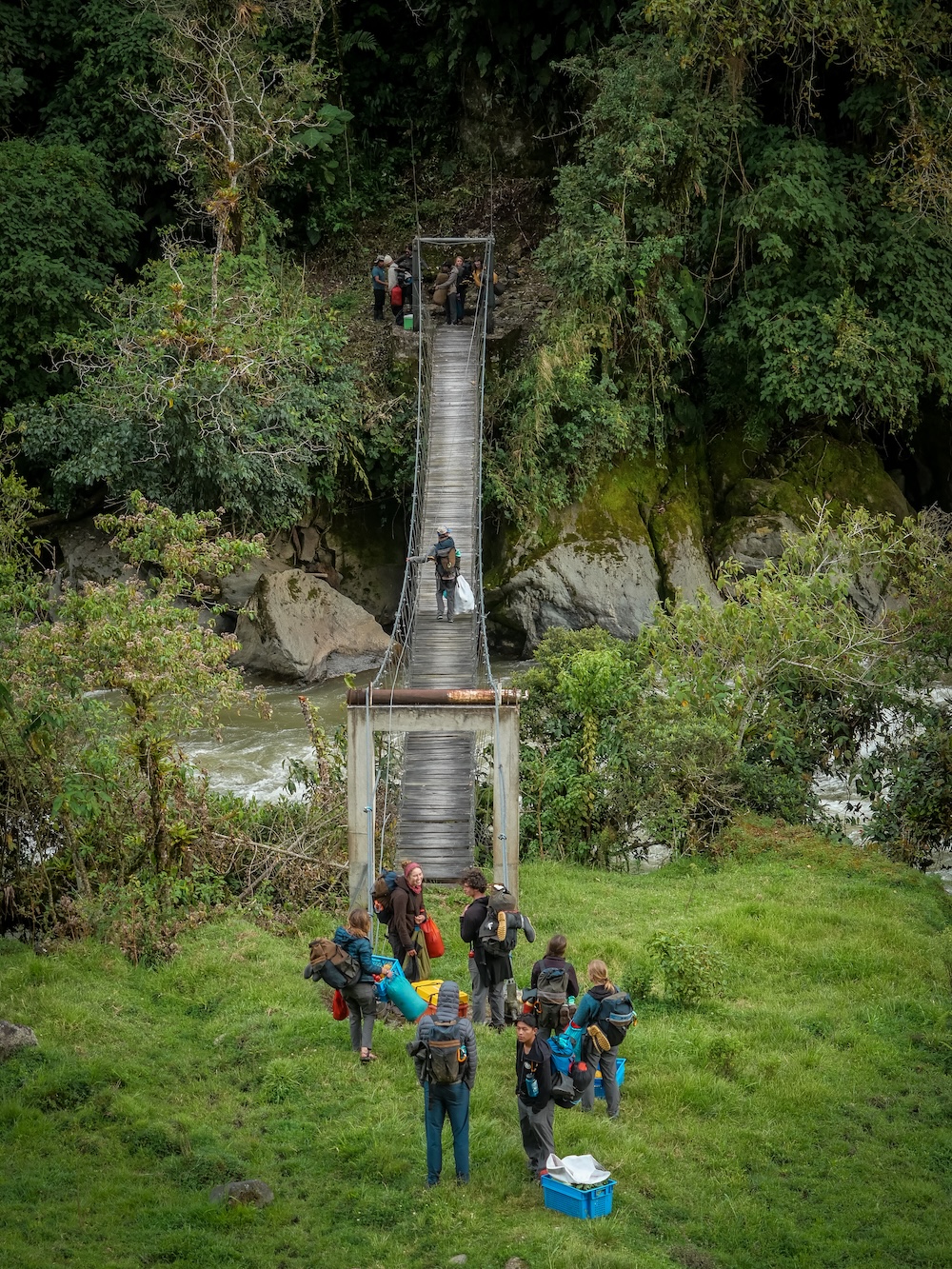
Crossing the bridge over the river and into Avispero

Visiting the waterfall
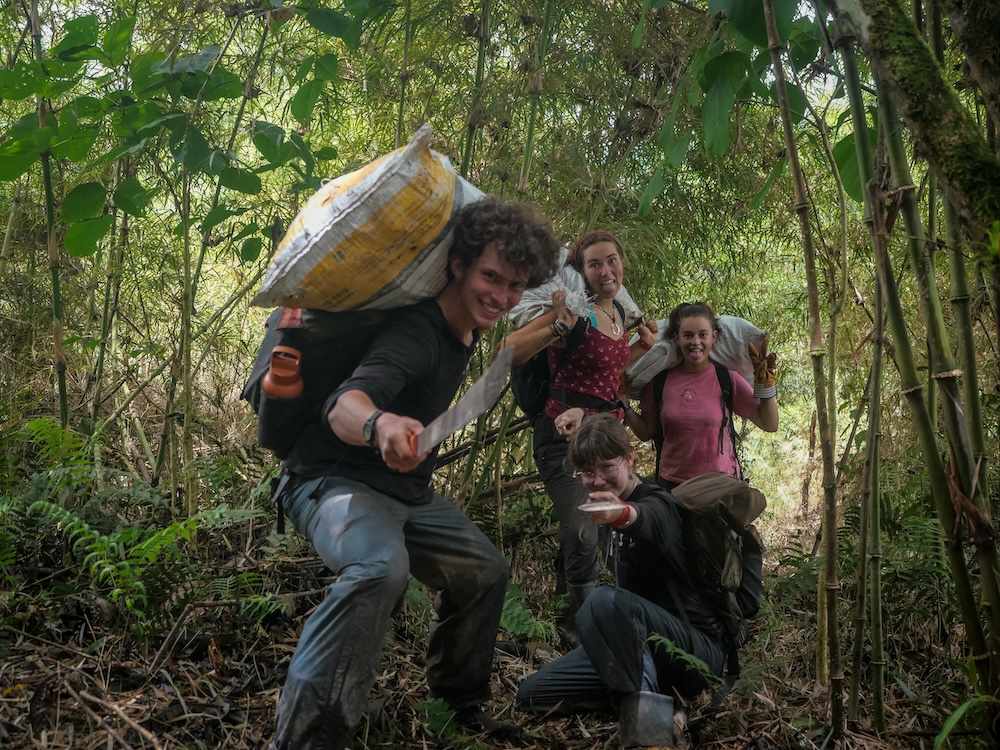
Moving bags of grass while Bennett and Alaya play with machetes
Arajuno and River School!
We woke early on the 25th to pack up camp and catch our bus to Arajuno. The five-hour bus ride down into the rainforest turned out to be a blast, minus a little bit of carsickness. We chatted and sang along to music (everyone was very excited about this after two months of exclusively Kroka songs) and even danced a little. We stopped for lunch, where we met Felipe, who would be our river guide, and, after some begging, we also stopped for ice cream!
In the afternoon we reached Arajuno, a little town by the Arajuno River, and ferried out the gear to our next home—a rustic camp right beside the river, perfect for river school! We were blessed with Marcia and Tomas’s company and support during this time as well. Geova also joined us!
After our intro to the jungle in Avispero, we were now in the true Amazon rainforest, complete with its humidity, bugs, and spiders! The sticky heat made us wish for shorts and tank tops, but we spent our time in wool sun shirts and long pants to protect ourselves from the vicious bugs. The rest of the insects and creatures were plentiful as well, with huge, strange bugs, dozens of brightly colored butterflies, and even a big, hairy tarantula the size of my palm on the first night!
On our first morning we began river school with Felipe and Tomas by learning about the movement of water and the water features it creates. We studied both the friendly water features like eddies and waves and the ones that we need to avoid at all costs, like strainers and undercuts. When we had learned and observed these features, we jumped into the water and practiced swimming safely with passive and aggressive techniques, and then had fun practicing swimming down the rapids.
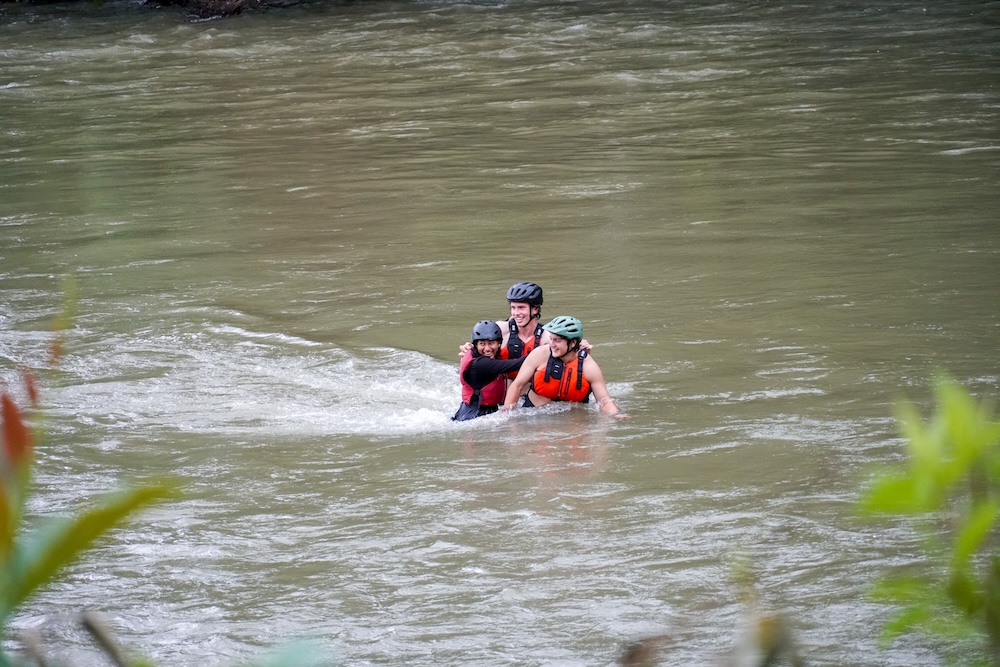
Wilcca, Bennett and Lore practicing safe river crossing

Grace and Alexa practicing with the rescue rope
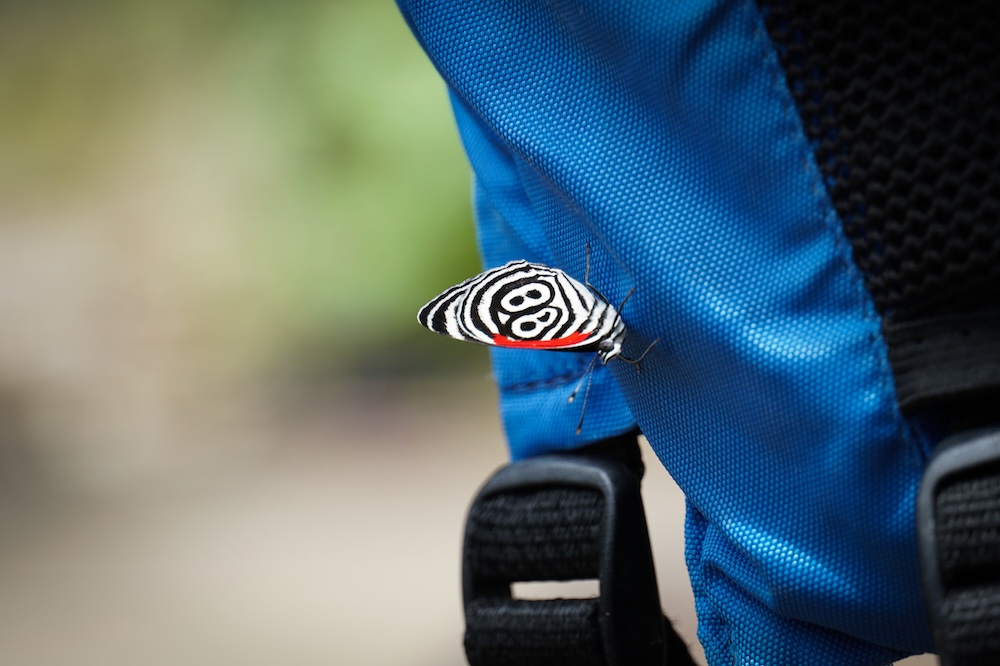
Beauty all around us
After a day spent learning the basics of river safety, we began working with the boats: two larger rafts and several tandem (two-person) rafts. We practiced ferrying across the river, steering, flipping and falling off, and then getting back on, and finally going down the small rapids. We all had lots of fun on the water, learning these new skills and enjoying the cool river.
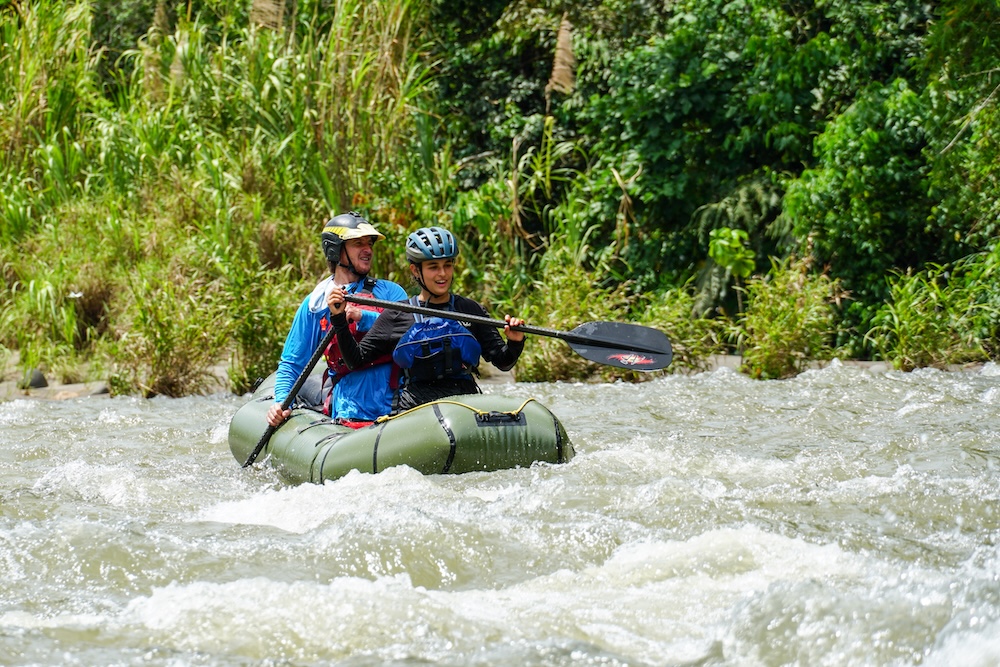
Clara and Felipe practicing the rapids
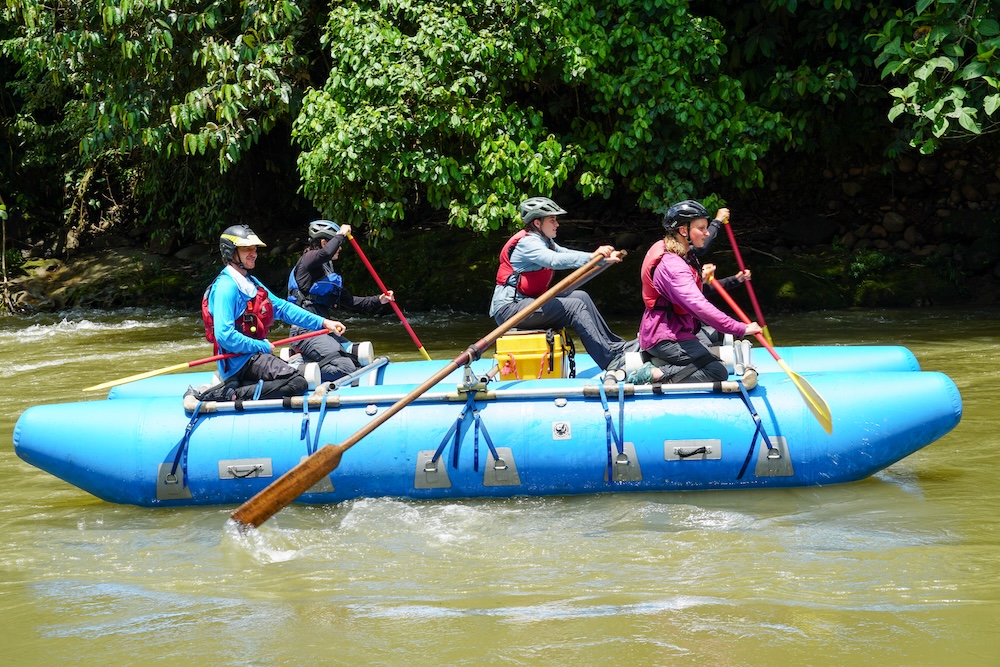
Learning how to paddle the Yuca
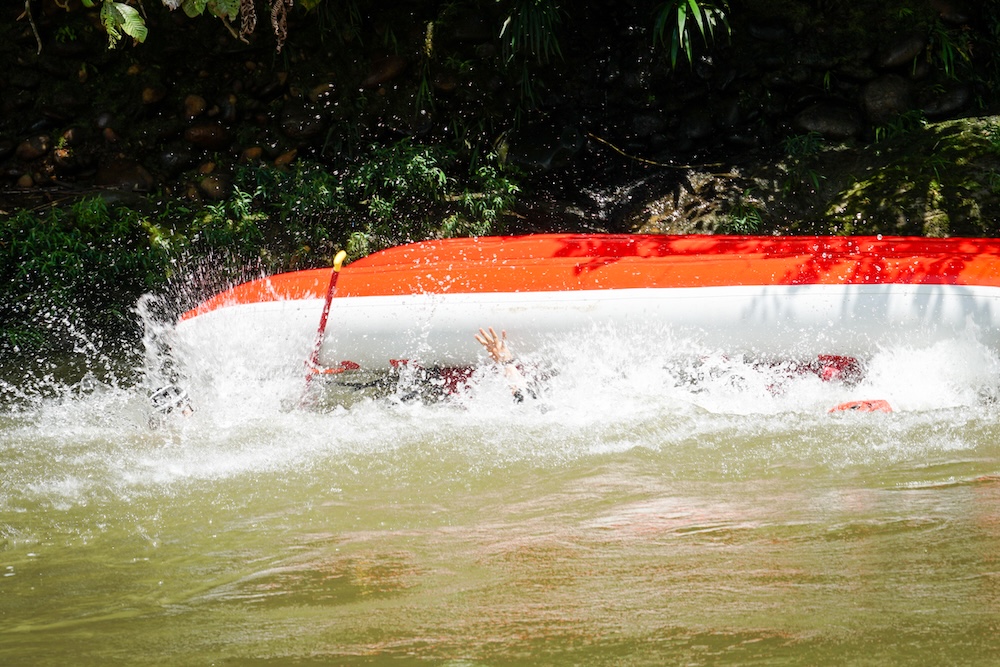
Intentionally flipping our cataraft…
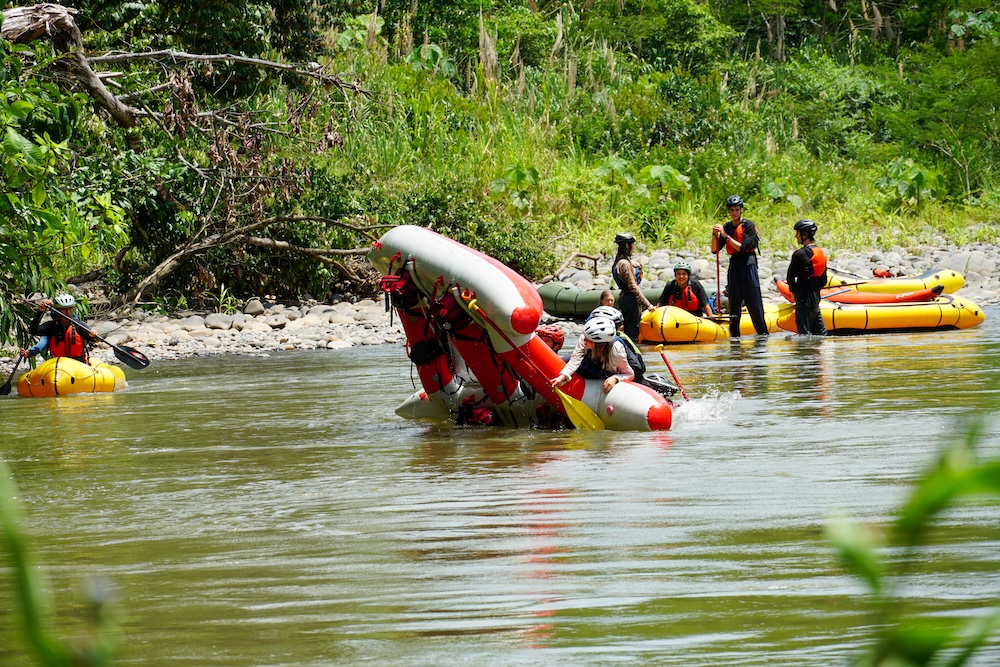
We learn to recover!
River school wasn’t just for practicing these skills; we would be using them for our one-day expedition down to Shiwakucha and then a final day to a town where we would meet the bus to return to Palugo. After our two days of river school, we put our skills to use, packing up our rafts with all our gear and heading downstream toward Shiwakucha. Atraue, a former semester student from the area of Shiwakucha, joined us for our day of paddling!
We took turns paddling the large rafts with all our gear and the small two-person boats, where we could practice navigating the rapids. After some rain, the river was high enough to make it fun and fast but still safe. We only had one boat flip, which was handled expertly and quickly on their own with a self-rescue. We spent about six hours on the river with a break for lunch. It was an incredible day of expedition as we paddled through the rainforest, enjoying the gorgeous scenes passing by.
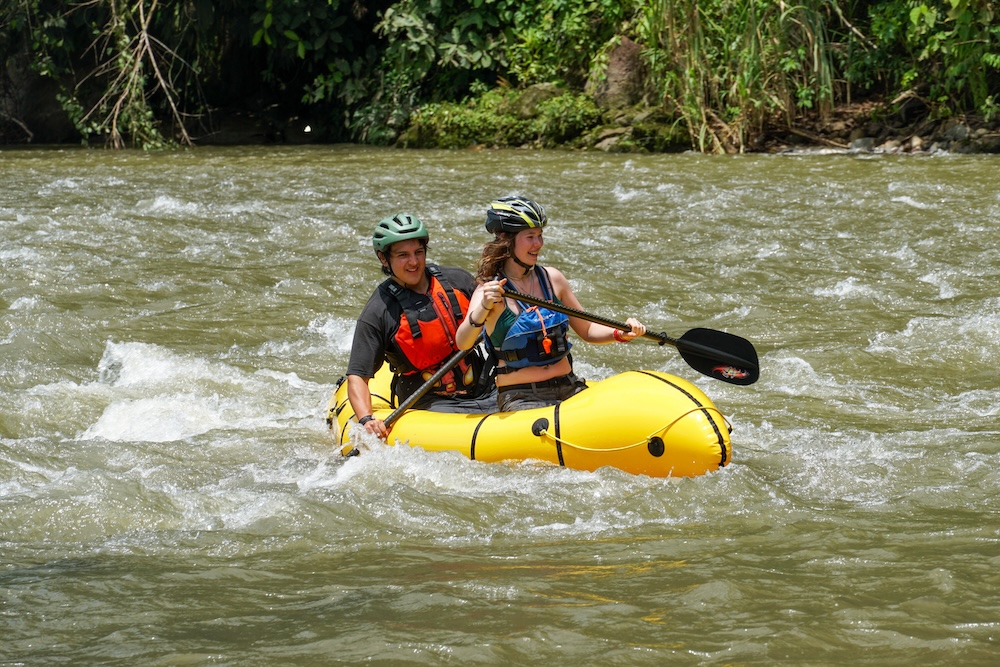
Wilcca and Alaya going down the rapids
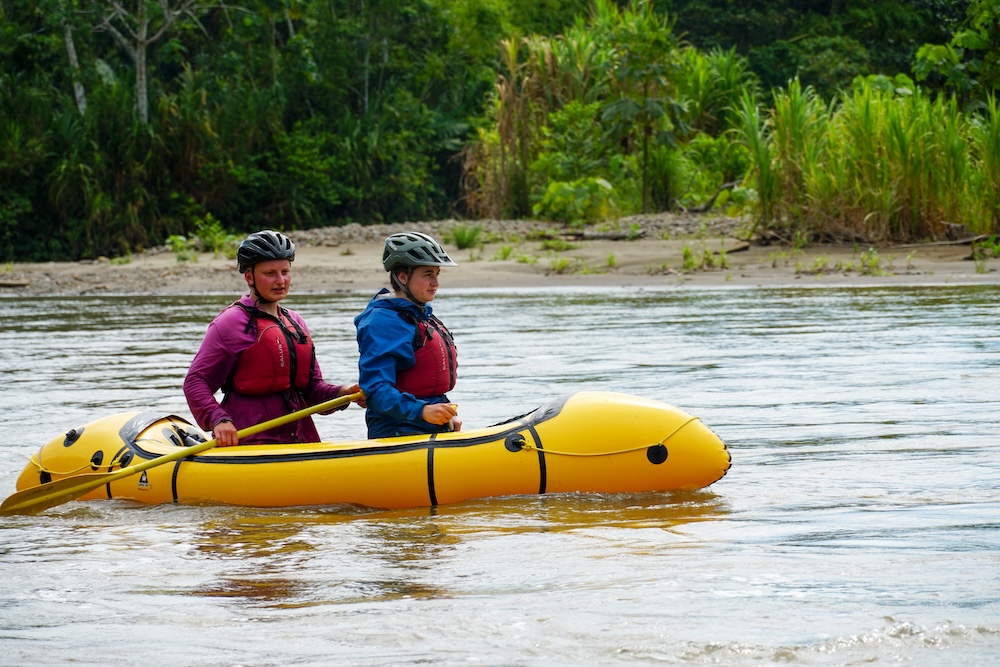
Davis and Lucia paddling
Our jungle song (In Kichua):
Ama tuta purinkachu
Ayambiga caminkawy
Ayambiga caminkawy
Ama tuta purinkachu
Do not walk in the night
Because the alligators will bite you
The alligators will bite you
Do not walk in the night
Shiwakucha
In the afternoon we finally arrived at Shiwakucha, a small riverside community where we would stay with Isolena’s family and learn about the indigenous culture and jungle life. We were welcomed with a warm meal and comfortable beds (with bug nets, thank goodness) in gorgeous open-air thatched buildings. On our first morning, a few of us woke up early for the traditional Guayusa ceremony. Beginning at 4:30 AM, we sat in the predawn darkness and drank Guayusa tea while sharing stories and dreams. Guayusa is a local plant used for energy and protection, and the peaceful morning ceremony was a beautiful way to start the day.
After breakfast we helped clear out another pond (something our group is already expert at from our first stay in Palugo!) so that the family can make it into a fish pond. We cut brush, dug trenches, and got into the shallow pond to pull out debris and logs.
In the afternoon Isolena led an herbal plant walk, sharing her wisdom of the plants here. She is so connected with each plant and its use and treats them with so much respect, asking permission before she uses it. We learned about new, unfamiliar plants that are useful for bug bites, fever, or digestion, and saw some familiar plants like turmeric and ginger! We also took a detour to meet Isolena’s niece’s pet monkey, who climbed down to eat bananas and drink chicha. We also harvested fruits from the calabash tree, large green orbs that grow straight from the trunk, which we would use the next day to make bowls!
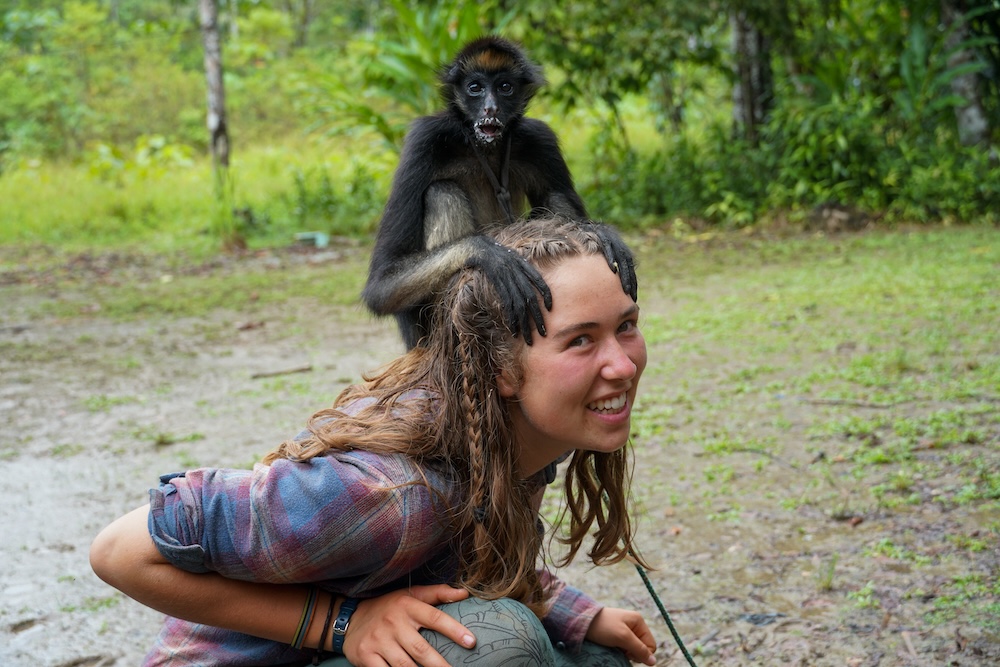
Dorothy and her new monkey friend Nemo
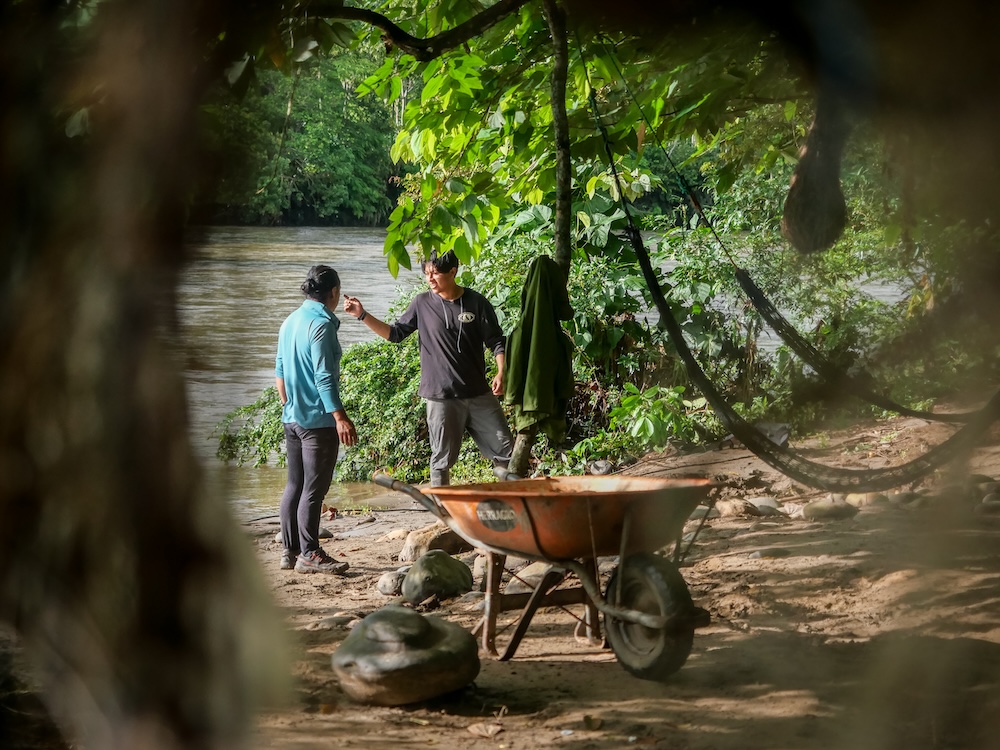
Jhordan and Geova gathering rocks for the paths
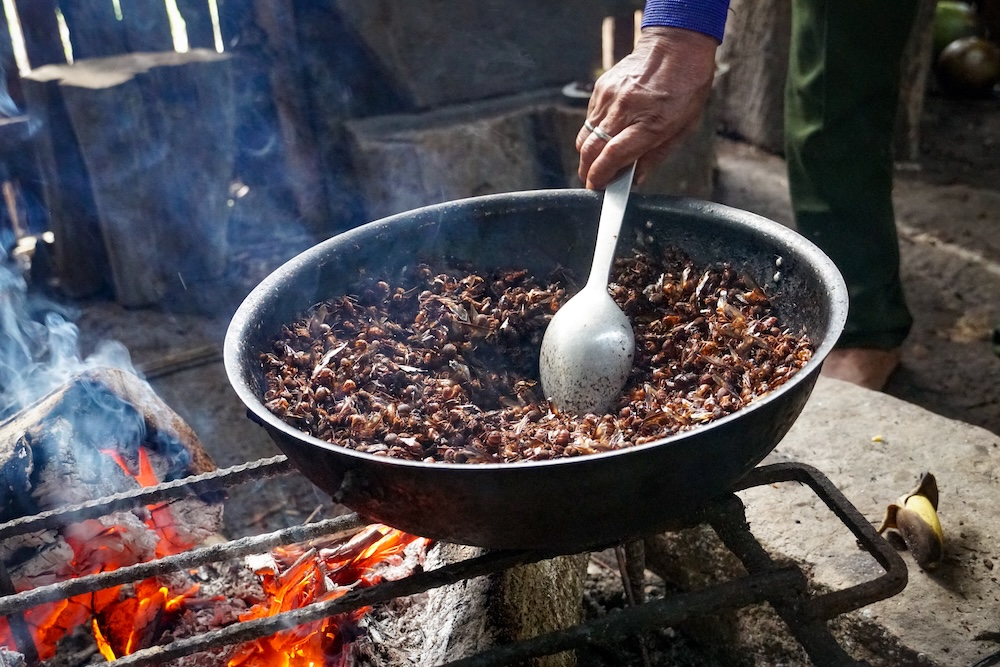
Tasty breakfast ants
We also got to try some new foods, including palm heart, a strange yellow fruit with hard red scales on the outside from one of the palms, and fried queen leaf-cutter ants that had been caught that morning. We also ate innumerable amounts of bananas and plantains.
After chores and breakfast we began our bowls. First, we cut the fruits and scraped out the soft white insides before boiling them. Then we did a second thorough scrape before carving beautiful patterns into the outsides of the bowls with a knife or a nail and setting them out to dry. The bowls vary in shape and size depending on the fruit, so we were able to create a wide range of bowls as well as some small, adorable cups. These traditional “pilche” bowls are used in the community for food, drinks, and ladles.
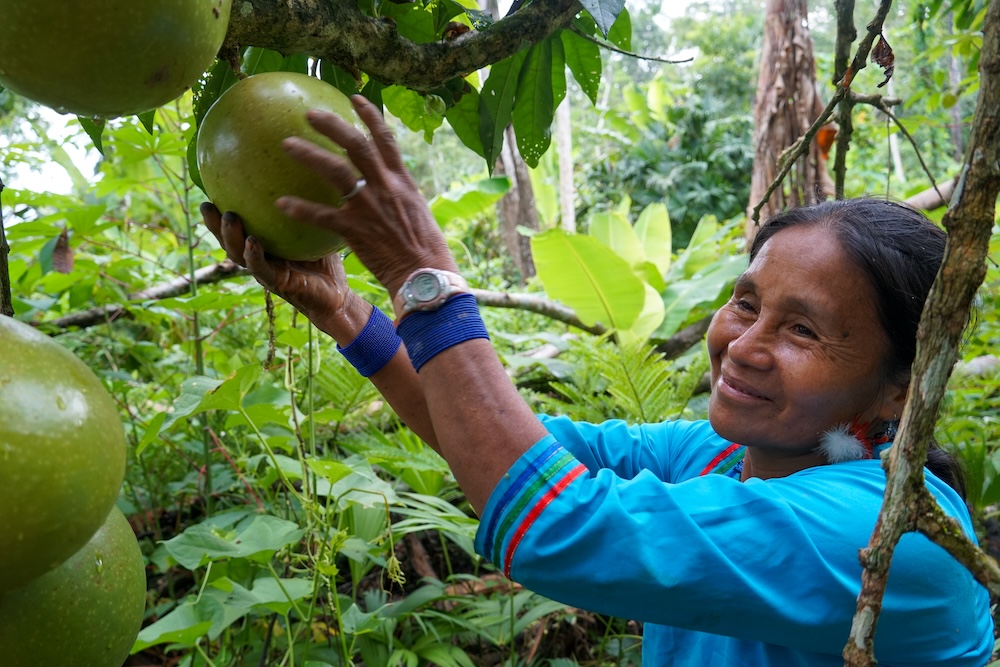
Mama Isolena gathering pilche fruits for our bowls
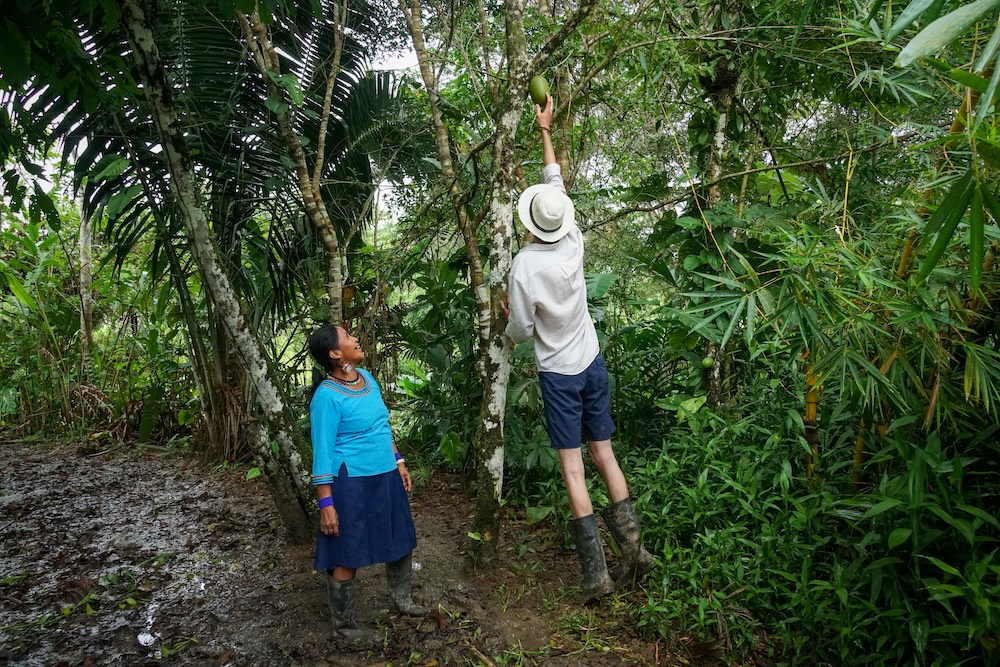
Finn picking pilche
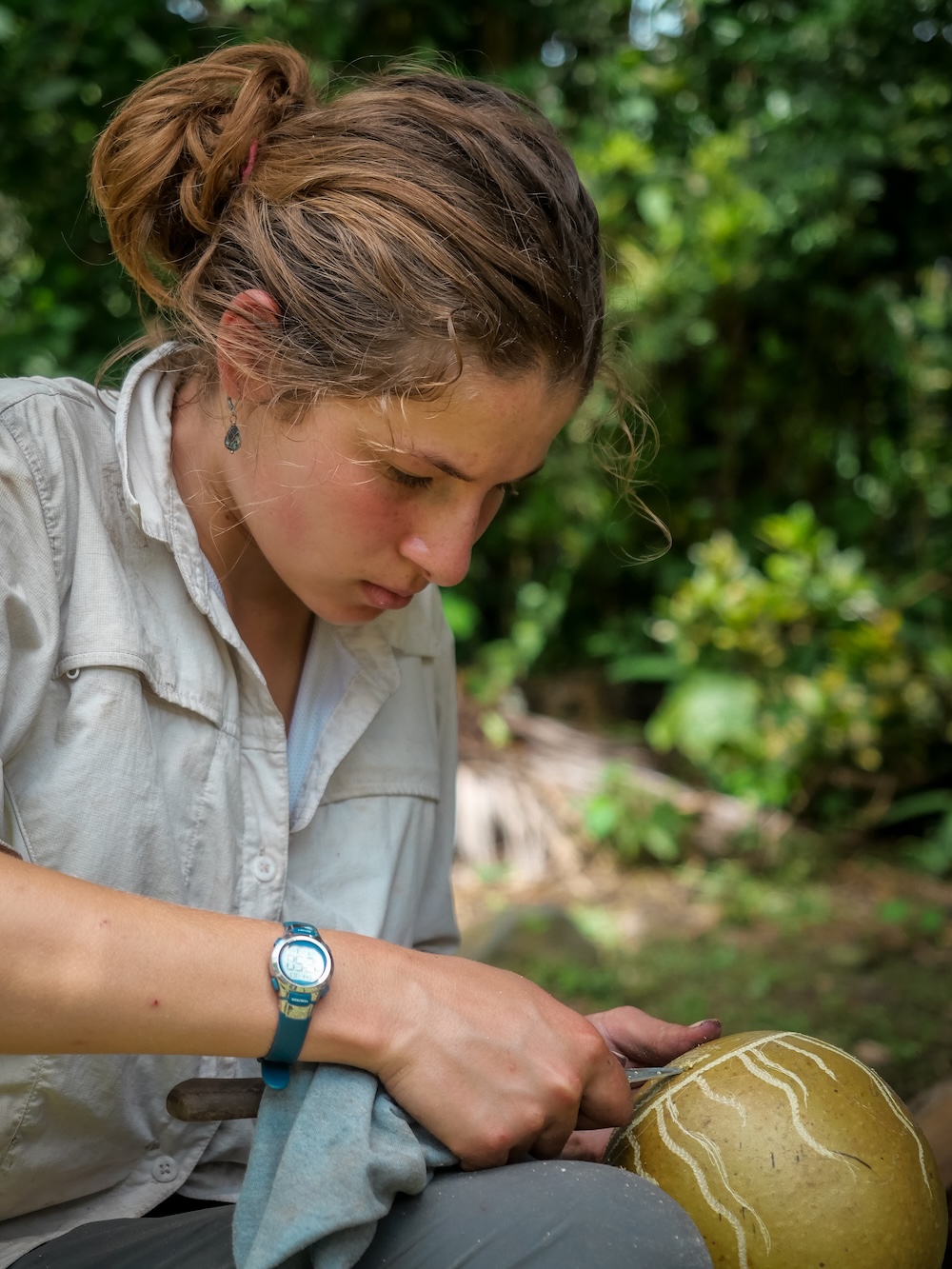
Ella decorating her pilche bowl

Dorothy, Rapha, and Bennett enjoying the process
To celebrate our time in Shiwakucha, we spent our final evening supporting the families by buying local crafts and using a local plant paint that leaves temporary tattoos. We all enjoyed giving and receiving beautiful, unique tattoos! We feel so grateful for the incredible warmth and generosity of Isolena and her family, and we will take so much with us from our time in the jungle.
The next morning we all woke early to join in the Guayusa ceremony and pack up camp before setting out on our final day of expedition. We spent another five hours paddling downstream to meet the bus. We made good time and had a swim stop to enjoy the river. Along our way we saw locals poling across the river, and Alexa and I found a chameleon floating downstream and rescued it. It spent the next hours on our heads, changing from yellow to green to brown. Soon after, we docked our boats and had lunch—meat and rice wrapped in leaves from Isolena—while waiting for the bus that would take us back to Palugo. After another fun bus ride full of music, singing, and another ice cream stop, we reached Palugo. We were all so excited to be back in this place that has started to feel like home and so grateful for all the adventures we have had during our time away.

Lindsay starting her new career as a tattoo artist
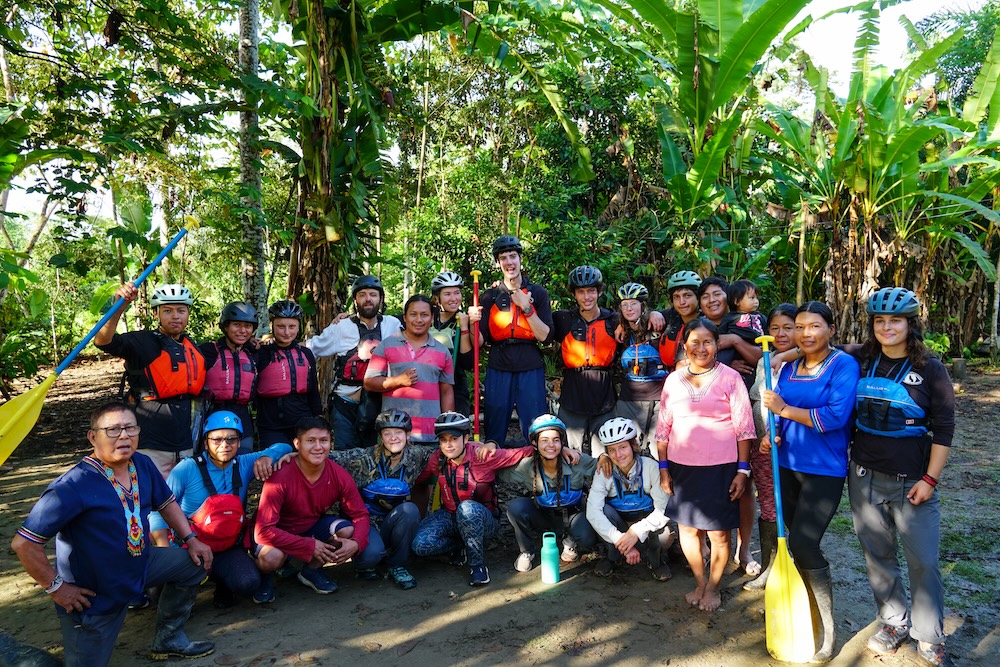
Leaving Shiwakucha

Davis and Lore paddling
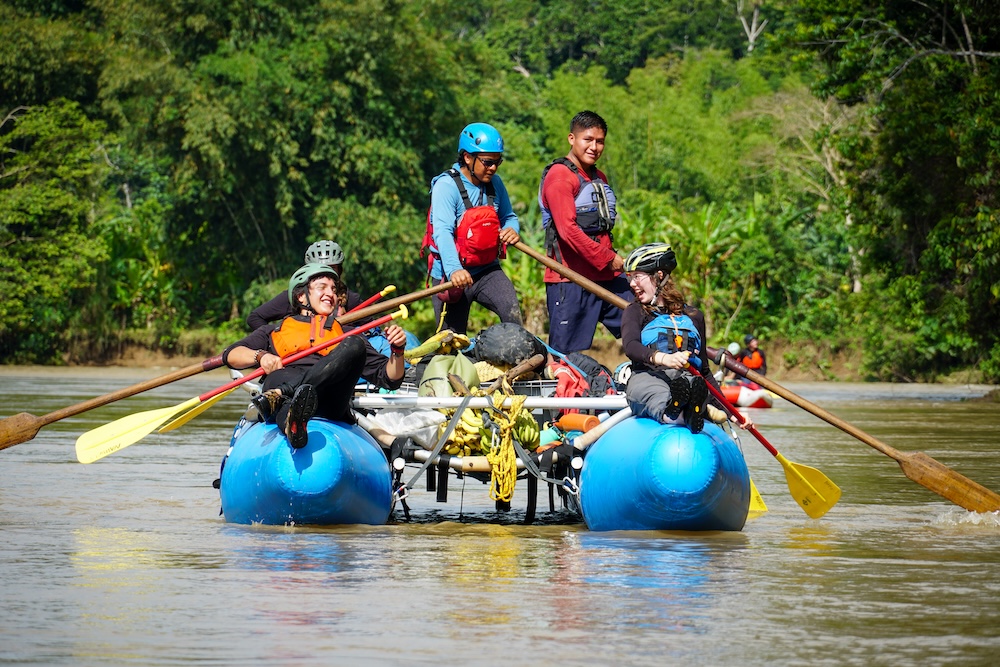
The Yuca and her crew
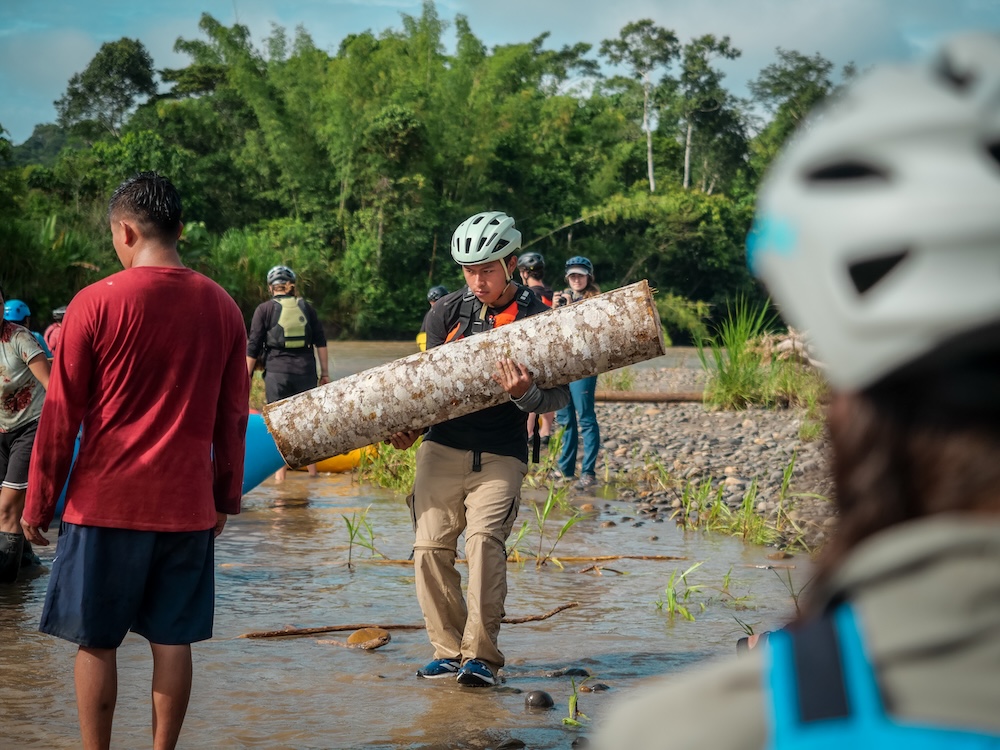
Jhordan helps locals move logs into their boat
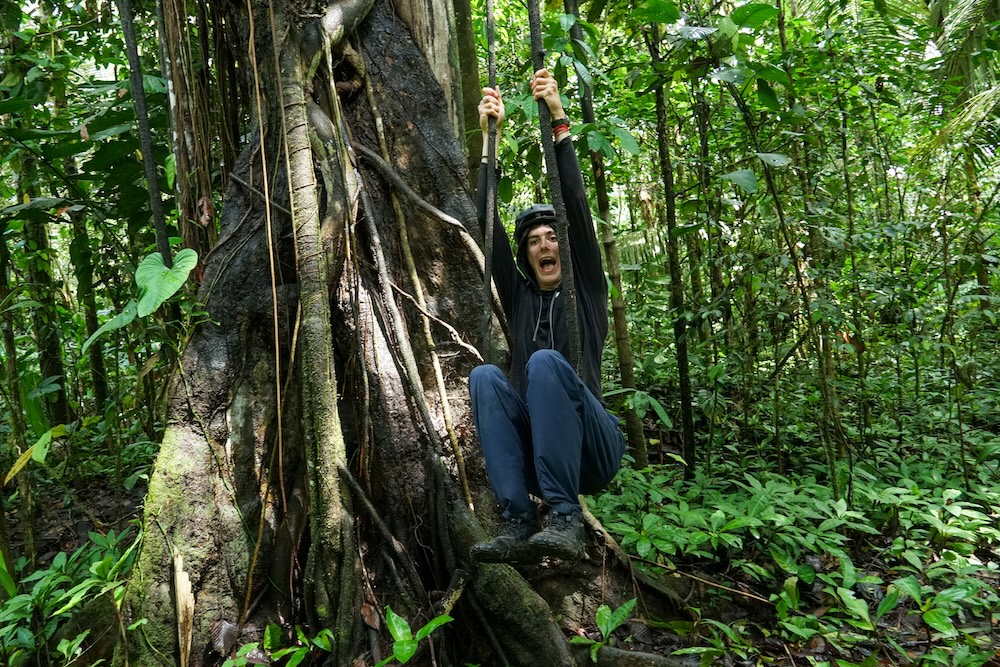
Finn explores the jungle
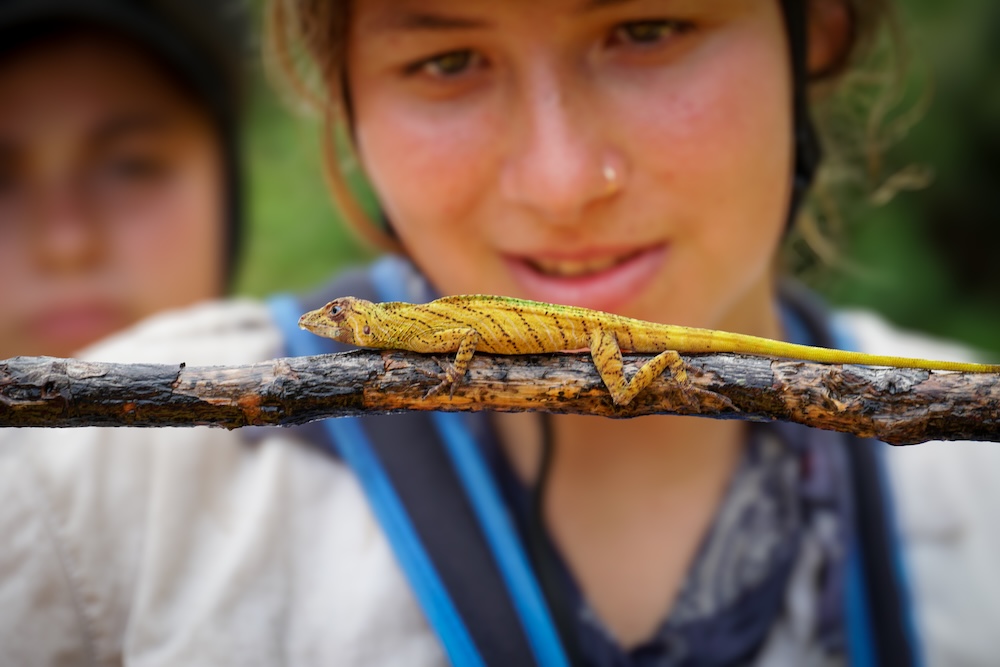
Ella and her chameleon friend
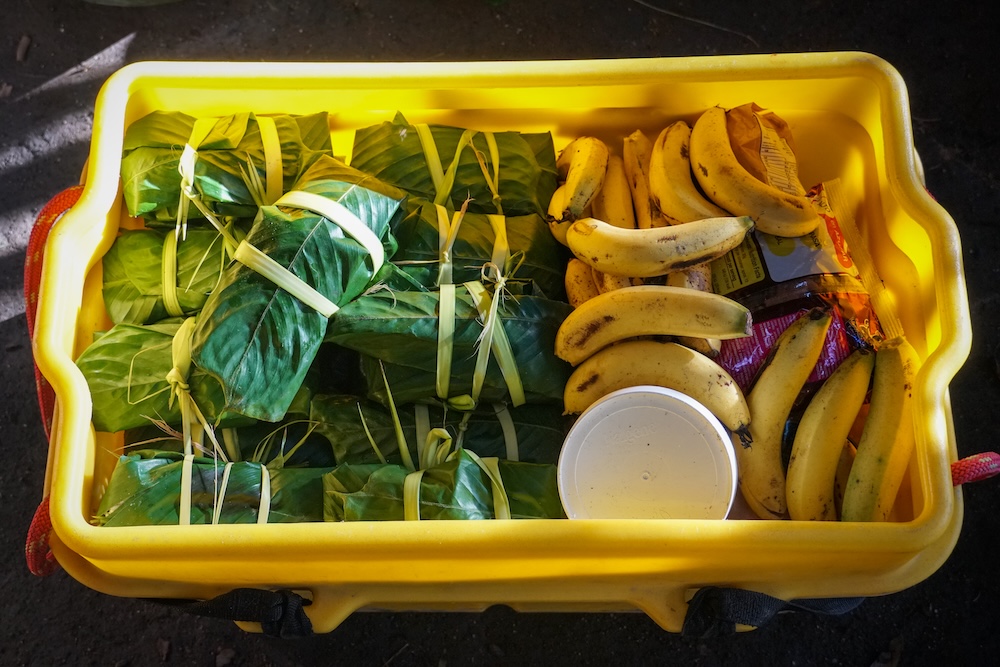
Our beautifully wrapped lunches ready to go!
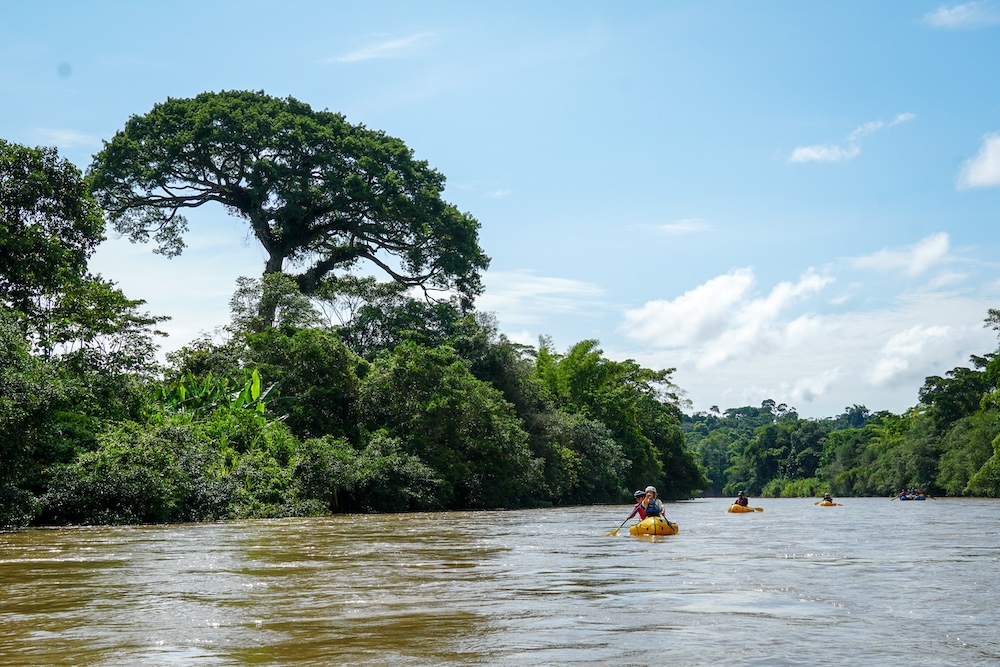
Paddling through the Amazon rainforest
Animal count
- Collared Trogen
- Inca jay
- Tucan
- Parrot
- Oropendulo (they made the coolest hanging nests)
- Great king fisher
- Faciated tiger egret
- Trantula
- Black poisonous spider
- Butterflies
- Boa
- Monkey (pet)
- Chameleon
Highlights from the Jungle
Bennett: My favorite thing from the jungle was spending time in the river hanging out.
Grace: An interesting moment for me was when Isolena brought me and my bug-bite-swollen feet to a tree, asked the tree for permission, made a slice in the trunk with a machete, and red liquid started leaking out. She collected it and rubbed it on my feet until it turned into a soapy white foam. I immediately felt relief from the itchiness and pain.
Clara: I loved all the colors of the plants. I’ve never seen such lush green trees or vibrant hues of flowers.
Lucia: I really enjoyed seeing all of the plants, many of which I know as cultivated tropical plants in the States: yucca, papaya, banana, ginger, turmeric, etc. Every plant has a use.
Lore: Mi favorito estaba el río, el plátano verde, las historias, y la guayusa acompañada de los sueños de la noche anterior. Son momentos que se quedarán en mí, también todas las tarántulas que vimos y los sostas que nos regalaron.
“My favorite things were the river, the green plantain, the stories, and the guayusa accompanied by the dreams from the night before. These are moments that will stay with me — along with all the tarantulas we saw and the sostas they gave us.”
Alaya: I loved learning about how the people learned to live in the thick, hot, humid, and incredibly diverse ecosystem. Learning about herbal medicine really stood out to me.
Wilcca: I really enjoyed the “yellow fellow” boat with Alaya. We had a blast paddling together and tipping…
Davis: I loved talking with Isolena and learning about her ten children and the uses of all her medicinal plants. I also loved paddling the river with Lucia and Lore and learning how to navigate the boats.
Finn: I enjoyed resting in the hammocks in the jungle and the rafting where we got to see all the beautiful scenery. The jungle is so alive.
Alexa: I loved the medicinal herb walk and learning how each plant has a use.
Jhordan: Una parte interesante de estar en la Amazonia fue aprender uno de los tradiciones en Tena: el té de guayusa temprano en las mañanas. Aprendí mucho sobre remedios medicinales de Isolena. En el Avispero, fue increíble ver un tragón tan cerca.
“An interesting part of being in the Amazon was learning one of the traditions in Tena — the early-morning guayusa tea. I learned a lot about medicinal remedies from Isolena. At El Avispero, it was incredible to see a tragón so close.”
Solena: I loved floating down the river and smelling the sweet, fresh air. It was like floating through heaven.
Ella: Dorothy and I got to experience the guayusa tea ceremony the first morning. It was so beautiful and peaceful, talking and drinking tea in the predawn light. I also loved learning more about the jungle ecosystems in Avispero.
HOME SWEET PALUGO
After almost a month away, we finally returned to Palugo. It felt like coming back home to familiar faces and rhythms. We delighted in Palugo meals, soft mattresses, dry clothes, and our cozy dwellings. We settled into our schedule of morning chores, academic blocks, and journaling sit-spot time. During our two weeks here, we focused on an academic push and on reflection and preparation for our final expedition.
We also had phone calls with our families during the first few days. It was so wonderful to share our stories and catch up with our loved ones, but at the same time it was a strange experience, leaving us all more homesick. Being back at Palugo and talking with families made us realize that we only have one month left! This is sad to realize, but at the same time we have our fair share of adventures left before we return home.
CELEBRATIONS
On our second day back (November 1st) we had a Halloween/Día de los Muertos celebration with the Dammers. We all dressed up in makeshift costumes, enjoying creating fun outfits and using face paint, joining the Dammer children to trick-or-treat at the three households. Walking from house to house in our silly costumes reminded us of childhood Halloweens and the joy of this tradition. Afterwards we returned to the Chozón to celebrate Día de los Muertos with local traditions. In Ecuador they celebrate this holiday with traditional foods and drinks: wawas de pan and colada morada. The colada morada, made from generational recipes, is a special version of the everyday drink colada and is made with dozens of fruits and spices to create a delicious purple drink. The wawas de pan, or bread babies, are bread dough shaped into babies with frosting, nuts, and fruit for decoration. It was a wonderful way to return to Palugo, a festive celebration that combined Halloween, which we were all missing, and new local traditions.
The next day we celebrated Grace’s birthday! We sang birthday songs, shared appreciations, and had delicious cake in celebration of our friend.
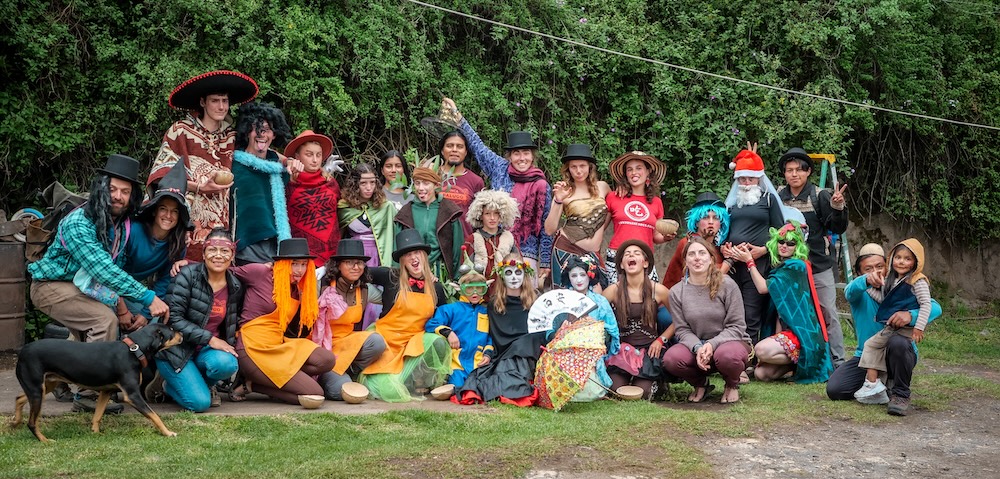
Happy Halloween!

Alaya, Solena and Alexa show off their fun costumes
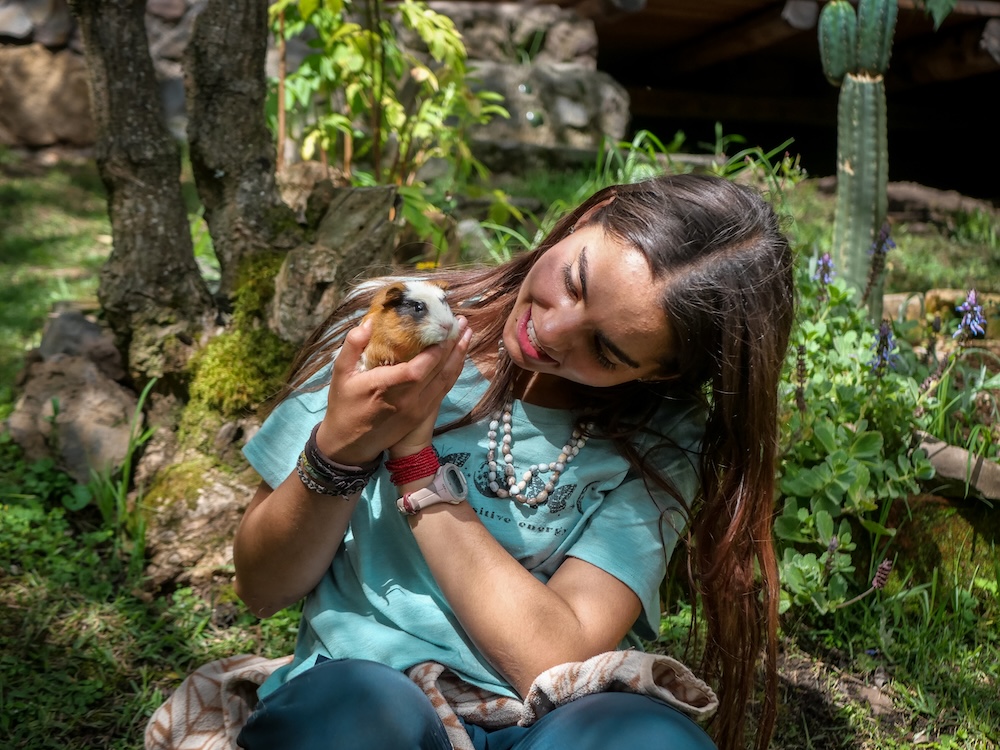
Happy Birthday to Grace with her favorite Cuy friend!
ACADEMICS
The biggest focus of this time in Palugo has been on academics. During the expedition, our only academics are journaling and the skills we are learning along the way, so this time back at Palugo was used to document this learning and focus on big academic projects. The main way we did this was by creating Book of Wisdom pages that focused on the skills we learned during the expedition. We also wrote an essay and completed a biography project.
We made a list of the topics we wanted to cover in our Book of Wisdom, including chocolate making, chores, paddling, biking, cultural diversity, crafts, and other knowledge we have gained along our journeys. We then created beautiful pages about these topics independently or with a partner. In addition to playing a large role in our academic credit, these pages will be combined at the end of the semester and copied so that we can each have this creative documentation of all that we learned.
Another big academic project has been biographies. With Marcella, we split into pairs and chose important figures in South American history. These figures were artists, activists, and revolutionaries who left powerful impacts on South America and the world. For this project we got books and articles to research our people, and then, after learning about their lives, began our final projects: a creative timeline and performance. For the performance, we could create any artistic representation of our learning, like skits, informational monologues, or songs, with the idea of telling history through the characters who made it. With our partners, we wrote scripts, planned props and blocking, and rehearsed before sharing our performances with the rest of the group and Palugo community. It was a joy to watch everyone’s skit and learn a bit about their character. Everyone approached the challenge differently, using humor, romance, drama, or song to tell their story.
Despite our busy workload, we still found time for other classes. We spent time with the Dammers learning about permaculture and animal care, had a class with Lindsay on constructive feedback, and enjoyed two classes with guest teachers. One was a lesson on the history of protests in Ecuador, taught by Marcella’s brother Ricardo. His class gave us context for the paros we encountered on our travels and a deeper understanding of Ecuador’s long tradition of protest. Our other guest class was with Zuko, a mountaineer (and Marcella’s stepbrother). After an injury left him paralyzed from the arms down, he continued to climb mountains with the support of friends, perseverance, and specially designed arm-powered bikes. We are incredibly grateful for both classes, which offered us profound wisdom and inspiration.
Academics are a vital part of the Kroka experience, but they are also a dramatic shift from expedition life. After biking and paddling all day with minimal academic work, suddenly spending full days in the chozón—sitting, studying, and crafting Book of Wisdom pages—was challenging. This past week many of us have felt stressed and tired. Even so, the way academics are approached here—learning practical, earth-centered, and human-centered skills, then expressing them through beautiful handmade pages—is a refreshing and meaningful way to experience school.
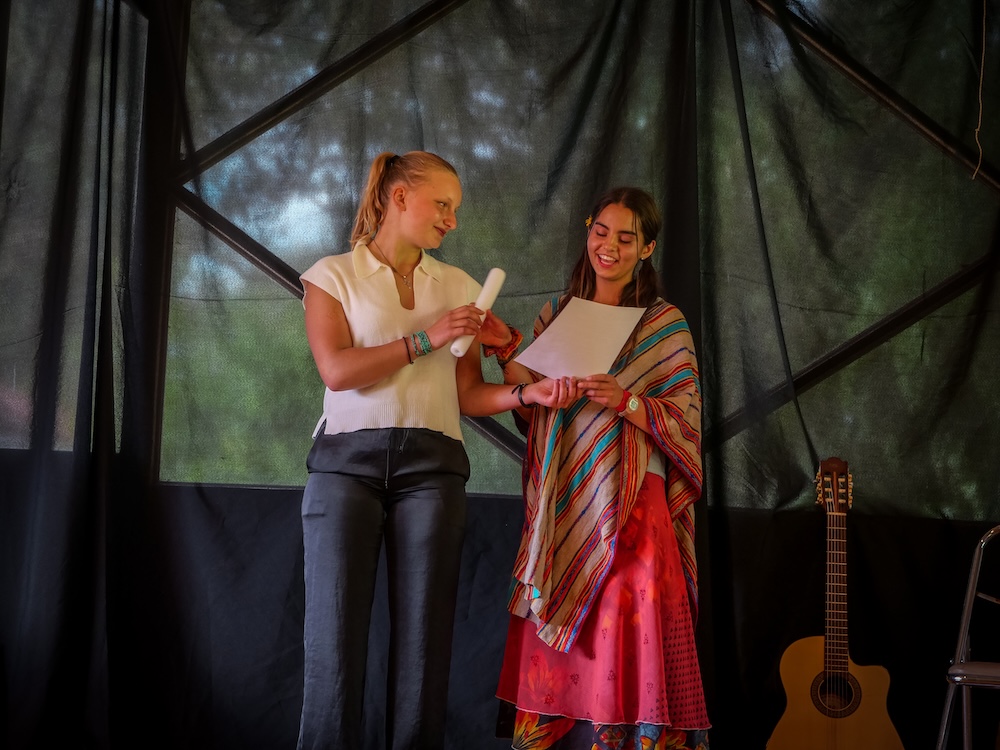
Lucia and Grace perform their Merecedes Sosa skit
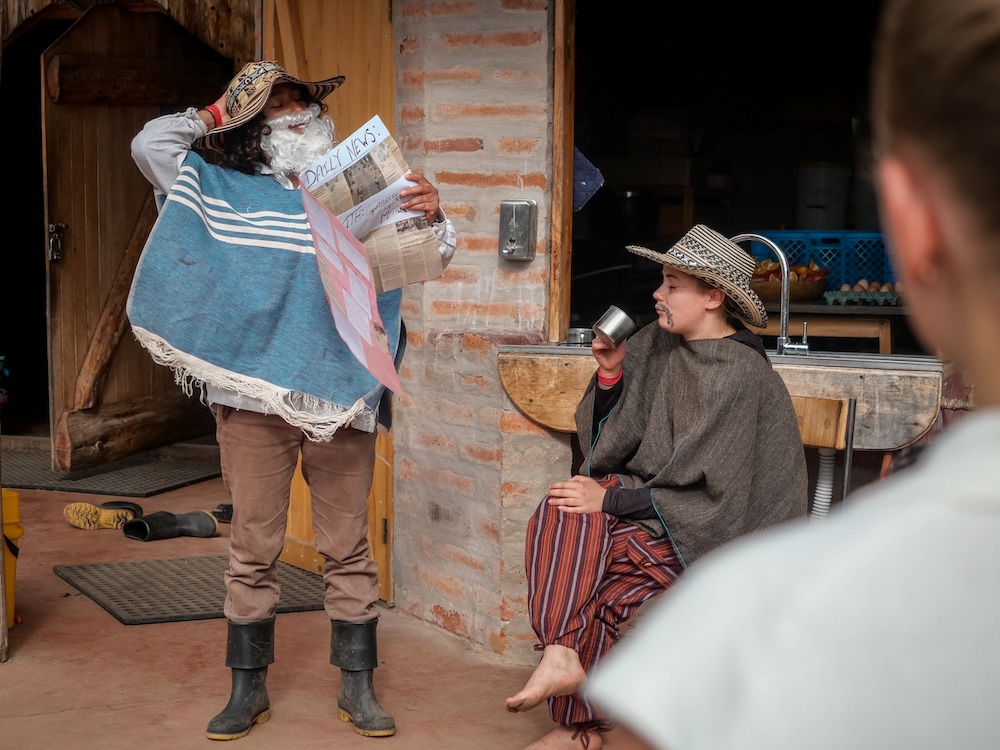
Lore and Alexa teach us about Gabriel Garcia Marquez
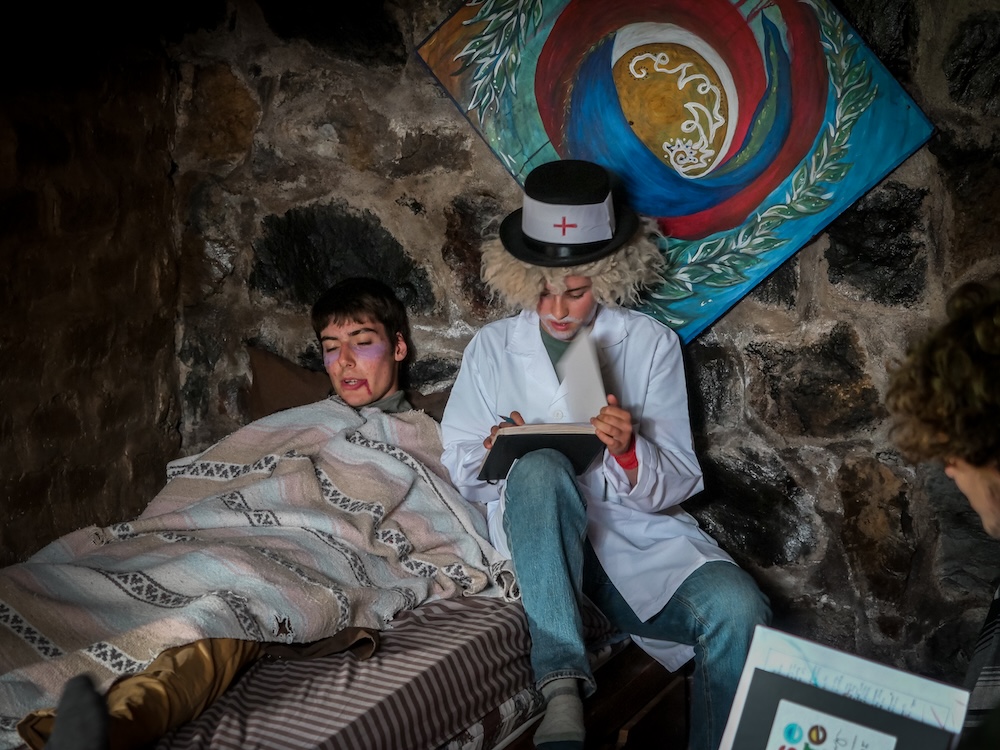
Finn and Davis act as a dying Simon Bolivar and his doctor
BUILDING PROJECT
We have also been working on our building project! We are creating a building to organize and process recycling and trash here at Palugo. This has been a great opportunity to work with our hands, practice using power tools, and help out the farm.

Finn and Clara work together to instal a foundation post
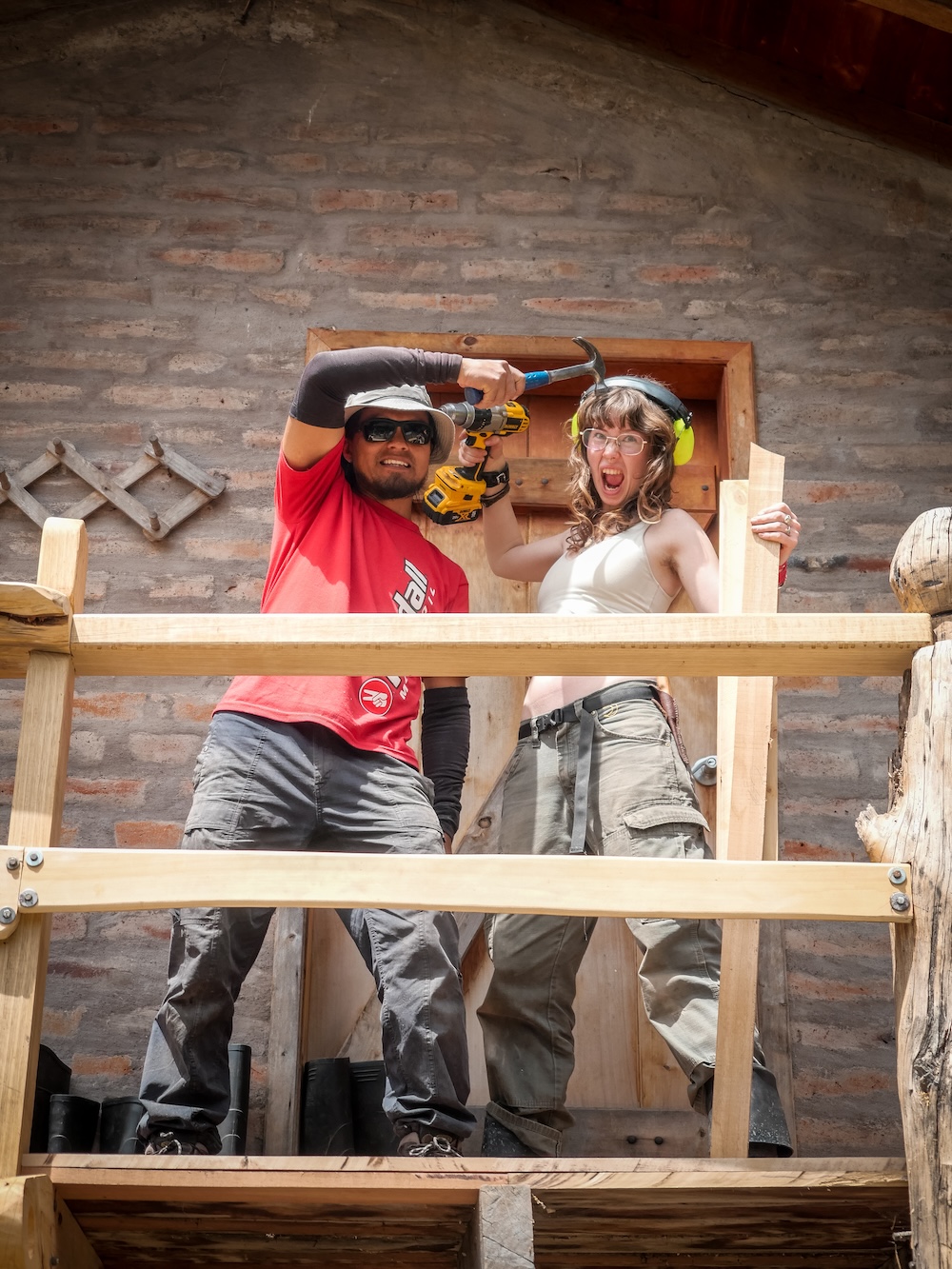
Alaya and Roberto use the tools unsafely
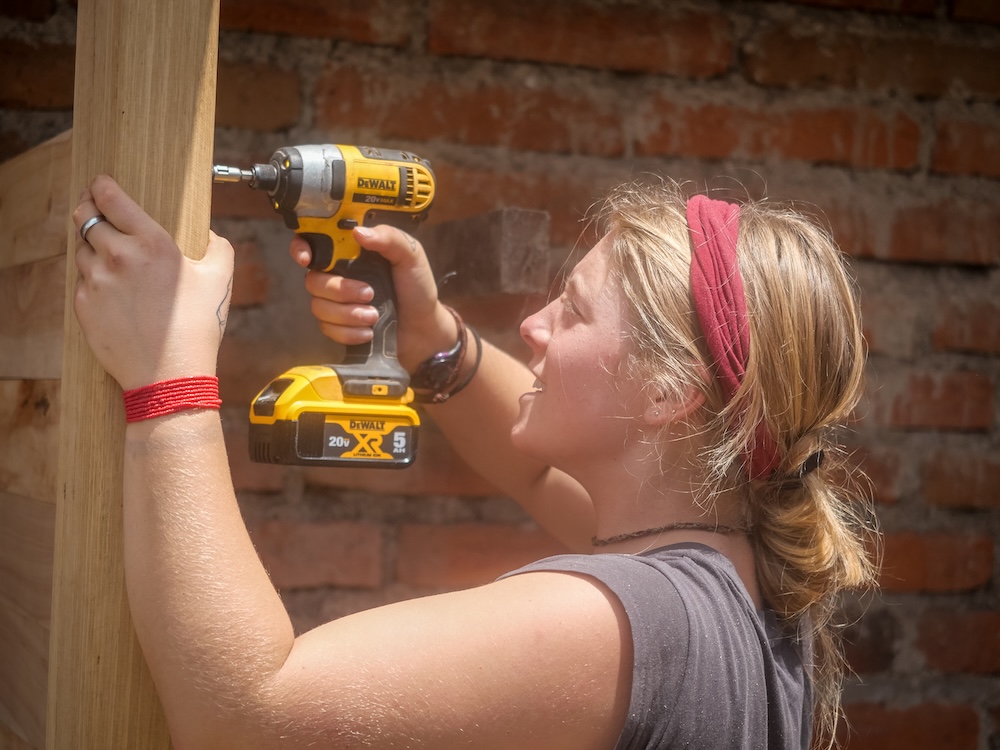
Solena drills
QUITO
Midway through our time here we loaded up in a van and left Palugo for an exciting and long-awaited day in Quito with Nikki, Matias and Lindsay. We spent the day learning about the city, exploring, and visiting the market. Located on the equator, the city has always had great spiritual meaning. Many sacred sites were built along this line where everything is aligned to the sun. Because of this, it was a sought-after city for both the Incan and Spanish colonizers. As we walked through the city, we learned about various churches and historical sites. We visited an art museum and saw the beautiful sculptures, crafts, and gold work made by the Indigenous people of Ecuador before colonization. It was incredible to see the art and learn a bit about the culture and significance. We got to go inside a beautiful church that took over 180 years to build and is filled with gold and intricately carved wood. After seeing a bit of the city and having a delicious lunch, we arrived at the market. We walked through the stalls, enjoying the wide array of trinkets and fibers, and bartering with vendors. We all supported the local vendors by purchasing fun little things to remind us of Ecuador.
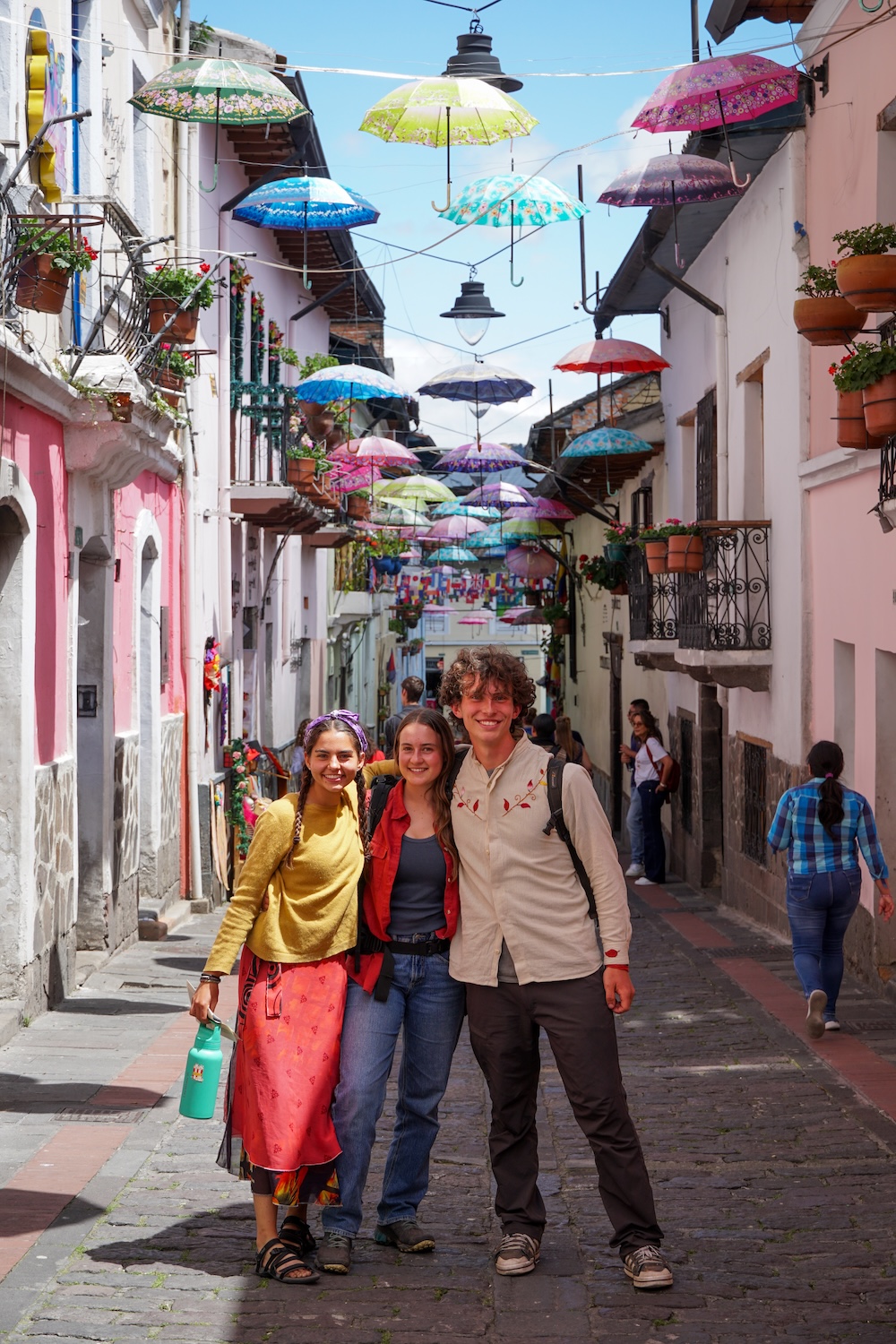
Grace, Davis and Bennett in the streets of Quito
SOLOS
May you know in your bones that this earth is your home
May you feel in your soul you are worthy and whole
May you know in your bones that this earth is your home
May you feel that you belong
– The song we sang to send us off into our solos
During our last few days in Palugo we had our long-awaited solos. For our solos, we spent 48 hours in our own spot in the woods without any food or human interaction. We were dropped off at 10 AM on Tuesday morning with only our rain gear, clothes, a sleeping bag (optional), and a tarp. We set up our shelters and settled in for two days of boredom, hunger, reflection, and solitude. The solo experience is a wonderful time for rest, reflection, and personal time amidst our busy social semester. It is also very hard. Not eating for that long, for some hardly sleeping, and simply having nothing to do is difficult. We all found our own ways of entertaining ourselves and experienced this challenge in different ways. I can’t speak for everyone, but I can say it was a powerful time for all of us and pushed us in new ways. On Thursday morning we returned to the chozón to break our fast and have some time for personal care and recovery.
How did we entertain ourselves?
Ella: I watched the swallows, the vultures, and the hawk, watched the clouds, lay in the sun, and narrated my experience as an alter ego, “Stewy Rodrigo.” I appreciated the moments of peace I found, watching the sun slowly set over the mountains.
Bennett: Some things I did to entertain myself on solo were sleep, talk to myself, sing, and count the vultures circling me.
Grace: I didn’t do a full solo, but during my long sit spot I thought a lot about change. A low for me was the disappointment of not doing a full solo.
Clara: I sang until I lost my voice.
Lore: Buscar la frecuencia de mi botella de agua, aullar con Rupango, subirme a los árboles y tirarme en la colina para sentir el sol, fueron mis momentos para entretenerme.
“Looking for the frequency of my water bottle, howling with Rupango, climbing trees, and rolling down the hill to feel the sun were the moments that kept me entertained.”
Alaya: Most of my time was spent thinking about food or counting each hour go by, day and night. I also counted how long Davis’s check-ins were and sat in the field trying to spot her drop off her water bottle — to no success…
Wilcca: I feel my most common thought was music that was stuck in my head all day and all night, and I nearly raided the pigs for their macadamia nuts.
Davis: The hardest part of my solo was not being able to sleep and how each minute felt like an hour. A highlight was meditating and sunbathing. I also experienced a fox grabbing my stuff sack that was right next to my head while I was in my sleeping bag, and then I saw it again the next morning, scampering through the field.
Finn: I spent a lot of time hitting a stick against a vine which, as you can imagine, got boring pretty quickly. On the first day I built my hut and went to sleep, and on the second day the hunger was setting in, so I thought a lot about food and a business plan of selling food and becoming rich.
Solena: I loved the timelessness and fluidity of the days. I’ve never counted the seconds up to a full hour before…
Jhordan: En el solo, los dos días fueron difíciles, pero me pude dar cuenta que en el año pasado dije: no va a ser igual este año, pero ahora estoy aquí con unas de las experiencias que también dije que jamás voy a hacer, pero mira, estoy aquí y también estoy aprendiendo.
“During the solo, the two days were difficult, but I realized that last year I said, ‘It won’t be the same this year.’ And now here I am, experiencing things I once said I would never do — but look, I’m here, and I’m learning too.”
Creations while we sat with ourselves:
A song by Grace:
Take me away, I’m going to a better place, where the sun will rise, and the light can reach my eyes,
Like a bird, like a bird, I will fly, run away run away, to your side,
Oh love, don’t you cry
A poem by Ella:
The world spins
Or so I know it must,
I couldn’t say
For me the hours seem to slow
Maybe they stop
The sun creeps and I wonder
How it’s only been a minute
I wonder if I’ll forget my name
In this place without time
I wonder if I’ll find myself
I wonder if the circling vultures notice me
I wonder if the world ends in solitude
A poem by Davis:
Depth is the warmth of community
holding hands
Depth is receiving wisdom from elders’ crystal balls
Depth is leaving your familiar clothing behind
when you visit a new culture
Depth is finding what paints a grin on your face
and a sunrise in your heart
Depth is the strum of a guitar
surrounded by a river of vowels
Depth is walking barefoot over smooth pebbles with nowhere to be
Depth is running free in your imaginary world
Depth is listening to your internal weather patterns
Depth is all around us,
just open your eyes
SETTING OUT FOR THE MOUNTAINS
As our time in Palugo comes to a close, we prepare for our final expedition: rock climbing in Cojitambo, backpacking around Cotopaxi, and finally attempting to summit Antisana. Our days have again turned to expedition prep, working in our Big Jobs to get everything ready and completing final projects. We prepared new gear, such as crampons, climbing shoes, mountaineering boots, and ice picks. We also celebrated the end of our second Palugo stay with another pizza night! We are filled with excitement for our incredible mountain adventures ahead and are ready to fully embrace the experiences of our last month of the semester.
Thank you so much for reading. I look forward to sharing our next adventures!
Sincerely,
Ella


